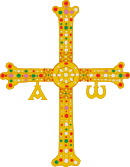- Church of Santo Adriano de Tuñón
-
Church of Saint Adrian of Tuñón
Iglesia de Santo Adriano de Tuñón (Spanish)
Basic information Location  Santo Adriano, Spain
Santo Adriano, SpainGeographic coordinates 43°17′29.9″N 5°58′49.9″W / 43.291639°N 5.980528°WCoordinates: 43°17′29.9″N 5°58′49.9″W / 43.291639°N 5.980528°W Affiliation Roman Catholic Province Asturias Year consecrated 891 Ecclesiastical or organizational status Church Architectural description Architectural type Church Architectural style Pre-Romanesque Specifications Length 14 metres (46 ft) Width 10 metres (33 ft) [1] The Church of Santo Adriano de Tuñón (Spanish: Iglesia de Santo Adriano de Tuñón) is a Roman Catholic Pre-Romanesque church in the village of Tuñón, Asturias, Spain dedicated to Saint Adrian.
The church is located on the bank of the River Trubia, next to an old Roman road. Founded on January 24, 891, by Alfonso III of Asturias and his wife Jimena of Navarra as a monastery church, it went through large transformations at the beginnings of the 12th century. It was declared a Spanish national monument in June 1931.
Architecture
The church stands on a classic basilica ground plan, although in the 17th and 18th centuries it was extended with a nave structure at the western end, and a bell gable. The fresco paintings in this church are the only remains of Mozarabic painters' work in an Asturian art workshop.
Notes
- ^ Arias Paramo 1992, p. 32
References
- Arias Paramo, Lorenzo (1992). "Geometría y proporción en la arquitectura prerrománica asturiana" (in Spanish). Actas del III Congreso de Arqueología Medieval Española (Oviedo: Universidad de Oviedo): 27–37. ISBN 8460419169. http://books.google.com/?id=2diqpqpbMeMC&pg=PA27. Retrieved 2009-05-31.
- Fernández Conde,, Francisco Javier; Pedregal Montes, María Antonia (1995). "Santo Adriano de Tuñón: Historia de un territorio en los siglos de transición". Asturiensia medievalia (8): 79–110. ISSN 0301-889X.
- Jordá Pardo, Jesús Francisco; Carmen Cabo, Gema Elvira Adán Alvarez (1991). "Excavaciones arqueológicas en Santo Adriano de Tuñón ( Santo Adriano, Asturias )" (in Spanish). Boletín del Real Instituto de Estudios Asturianos 45 (137): 357–396. ISSN 0020-384X.
- Mªdel Carmen MARQUEZ URIA (1977) Nº 90 ,Sto.Adriano:Las excavaciones del conde de la Vega del Sella[1]
- http://tematico.asturias.es/cultura/ridea/ConsultaBoletines/PDFs/090-18.PDF
Pre-romanesque art in the Kingdom of Asturias Pre-Romanesque art in Asturias is framed between the years 711 and 925, the period of the rise and extension of the Kingdom of Asturias.Architecture 1st Period (737 to 791)2nd Period (791 to 842)3rd period (842 to 866)Church of Santa María del Naranco • Church of San Miguel de Lillo • Church of Santa Cristina de Lena4th period (866 to 910)5th period (910 to 925)
Infrastructure La FoncaladaMajor figures Minor arts Spiritual legacy Categories:- 890s architecture
- 9th-century church buildings
- Churches in Asturias
Wikimedia Foundation. 2010.
